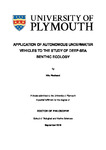APPLICATION OF AUTONOMOUS UNDERWATER VEHICLES TO THE STUDY OF DEEP-SEA BENTHIC ECOLOGY
| dc.contributor.supervisor | Howell, Kerry L. | |
| dc.contributor.author | Piechaud, Nils | |
| dc.contributor.other | School of Biological and Marine Sciences | en_US |
| dc.date.accessioned | 2020-10-28T13:52:13Z | |
| dc.date.available | 2020-10-28T13:52:13Z | |
| dc.date.issued | 2020 | |
| dc.date.issued | 2020 | |
| dc.identifier | 10540988 | en_US |
| dc.identifier.uri | http://hdl.handle.net/10026.1/16607 | |
| dc.description.abstract |
Rising anthropogenic pressure in the deep sea prompts concerns for its short and long term conservation, however, it remains mostly unexplored. Effective conservation strategies need to be based on a sound understanding of the target ecosystem, or ecosystems, which is not the case in the deep sea, owing largely to the lack of sufficient data. Autonomous Underwater Vehicles (AUV) could help address several long-standing challenges in the study of deep-sea ecology, thanks to their capacity to efficiently sample this remote environment. This thesis aims to investigate how these vehicles can contribute to the study of deep-sea benthic ecology through applying AUV acquired data (presented in chapter 2) to address fundamental questions in deep-sea ecology (Chapters 3 and 4), as well as asking how the benefits of AUVs, their capacity to quickly gather data in the form of large numbers of seafloor images, can be fully realised (Chapter 5). The research conducted in this thesis suggests AUVs are able to quickly and efficiently obtain representative samples, allowing efficient and statistically robust quantification of the density and diversity of benthic epifauna. They can also successfully detect consistent structure in the fine scale distribution of a model benthic epifaunal species (Syringammina fragilissima). However, the AUV derived dataset, including high resolution data on environmental variables, failed to clearly establish the environmental parameters driving this distribution. This suggests that although AUVs are capable of gathering large high-resolution datasets, the number of data-points is not the only important criterion for a representative sample. Finally, the application of Computer Vision and Artificial Intelligence methods to the AUV data set demonstrated that useful results can be obtained for some taxa, and the fast development of this technology promises future progress. | en_US |
| dc.language.iso | en | |
| dc.publisher | University of Plymouth | |
| dc.rights | Attribution 3.0 United States | * |
| dc.rights.uri | http://creativecommons.org/licenses/by/3.0/us/ | * |
| dc.subject | Deep-sea | en_US |
| dc.subject | Ecology | en_US |
| dc.subject | Benthic Ecology | en_US |
| dc.subject | AUV | en_US |
| dc.subject | Computer Vision | en_US |
| dc.subject | Species Distribution Modelling | en_US |
| dc.subject.classification | PhD | en_US |
| dc.title | APPLICATION OF AUTONOMOUS UNDERWATER VEHICLES TO THE STUDY OF DEEP-SEA BENTHIC ECOLOGY | en_US |
| dc.type | Thesis | |
| plymouth.version | publishable | en_US |
| dc.identifier.doi | http://dx.doi.org/10.24382/747 | |
| dc.rights.embargoperiod | No embargo | en_US |
| dc.type.qualification | Doctorate | en_US |
| rioxxterms.funder | Not available | en_US |
| rioxxterms.identifier.project | Ph.D. studentship from the School of Biological Sciences, Plymouth University | en_US |
| rioxxterms.version | NA | |
| plymouth.orcid.id | https://orcid.org/0000-0002-7408-7415 | en_US |
Files in this item
This item appears in the following Collection(s)
-
01 Research Theses Main Collection
Research Theses Main



